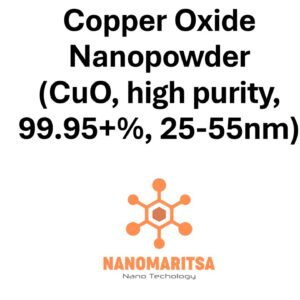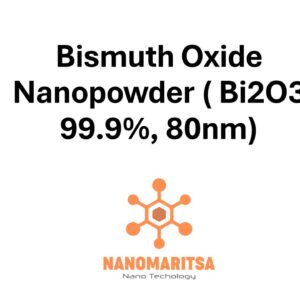Indium Oxide Nanopowder (In2O3, 99.99%,high purity, 20-70nm)
€360.00
CompareIndium oxide nanopowder (In₂O₃, 99.99%, high purity, 20–70 nm) is a high-performance material used in various advanced applications due to its excellent electrical, optical, and chemical properties. The nanopowder’s small particle size and high purity make it suitable for use in electronics, optoelectronics, catalysis, and environmental technologies. Its unique characteristics, such as semiconducting behavior and transparency, enable innovations in a variety of fields.
Composition and Structure
In₂O₃ (Indium Oxide):
Indium oxide is a compound composed of indium and oxygen. It is a wide-bandgap semiconductor that exhibits n-type conductivity, making it useful in transparent conducting films and various electronic devices. Indium oxide has a cubic crystal structure and can be modified to achieve specific properties such as increased conductivity or transparency.
Purity (99.99%):
The high purity level of 99.99% ensures that the nanopowder contains minimal contaminants, which is essential for applications that require precise material properties, such as in high-performance electronics or optical devices.
Particle Size (20–70 nm):
The nanopowder’s particle size in the range of 20 to 70 nm offers a high surface area and increased reactivity, which enhances its performance in applications such as sensors, catalysis, and energy storage. The size also allows for the tuning of optical and electrical properties for specialized applications.
Properties
- Semiconducting Properties:
Indium oxide is a wide-bandgap semiconductor, meaning it has a large energy difference between the valence band and conduction band. This allows it to conduct electricity under specific conditions, making it useful in a variety of electronic devices. - Transparency and Optical Properties:
In₂O₃ is optically transparent in the visible light range while maintaining its electrical conductivity. This makes it valuable in transparent electronics, touchscreens, and display technologies. - High Electrical Conductivity:
Despite being a semiconductor, indium oxide can exhibit high electrical conductivity, especially when doped with other elements. This makes it suitable for use in transparent conductive films and other electronic applications. - Catalytic Properties:
Indium oxide exhibits catalytic activity in various reactions, particularly in oxidation and reduction processes. Its high surface area increases its reactivity, making it a useful catalyst in industrial processes. - Chemical Stability:
Indium oxide is chemically stable and can withstand a variety of environmental conditions, including exposure to heat and moisture, making it a durable material for many applications.
Applications
1. Electronics and Optoelectronics:
Transparent Conductive Films:
Indium oxide is widely used in the production of transparent conductive films, which are essential components in devices such as touchscreens, flat-panel displays, and solar cells. Its combination of electrical conductivity and optical transparency makes it ideal for these applications.
Semiconductor Devices:
In₂O₃ is used in semiconductor applications, such as thin-film transistors and photodetectors, where its semiconducting properties enable efficient performance.
Solar Cells:
Indium oxide is utilized in the fabrication of thin-film solar cells due to its high electrical conductivity and optical transparency, which help improve the efficiency of energy conversion.
2. Catalysis:
Catalysts for Oxidation Reactions:
Indium oxide nanopowder is used as a catalyst in oxidation reactions, such as the oxidation of carbon monoxide and hydrocarbons. Its high surface area and catalytic properties enhance reaction rates and make it suitable for air purification systems and industrial processes.
Catalytic Converters:
In₂O₃ is also used in catalytic converters for automobiles, where it helps reduce harmful emissions by facilitating the breakdown of pollutants.
3. Gas Sensing:
Gas Sensors:
Indium oxide is widely used in gas sensors for detecting gases like carbon monoxide, nitrogen dioxide, and methane. Its electrical conductivity changes in response to gas concentrations, allowing it to function effectively in environmental monitoring and safety systems.
Environmental Monitoring:
The nanopowder’s ability to detect and respond to various gases makes it valuable in environmental and industrial monitoring applications, where it helps detect pollutants and hazardous substances.
4. Energy Storage and Conversion:
Batteries and Supercapacitors:
Indium oxide is being explored for use in energy storage devices, such as lithium-ion batteries and supercapacitors, where its conductive properties enhance performance and capacity.
Photocatalysis:
Indium oxide nanoparticles can be used in photocatalytic applications, including the conversion of solar energy to chemical energy, such as hydrogen production from water splitting or pollutant degradation under UV light.
5. Environmental Applications:
Water Treatment:
Indium oxide is being studied for use in water purification and treatment systems, where it can act as an adsorbent for contaminants such as heavy metals and dyes, thanks to its large surface area and catalytic properties.
Pollutant Degradation:
Due to its photocatalytic properties, In₂O₃ can be used to break down environmental pollutants in air and water, contributing to environmental remediation efforts.
Safety and Handling
Health Considerations:
Indium oxide is considered to be low in toxicity; however, nanoparticle forms can pose risks related to inhalation or skin contact. It is essential to handle the material with appropriate protective equipment, such as gloves, masks, and eyewear, to avoid exposure.
Environmental Impact:
Indium oxide is generally considered to have low environmental impact, though, like other nanomaterials, research is ongoing to assess its long-term effects on ecosystems. Proper disposal and handling procedures should be followed to ensure environmental safety.
Summary
Indium oxide nanopowder (In₂O₃, 99.99%, high purity, 20–70 nm) is a versatile material with a broad range of applications, including transparent conductive films, semiconductors, catalysis, and energy storage. Its unique combination of semiconducting, optical, and catalytic properties makes it valuable for advanced electronics, environmental sensing, and renewable energy technologies. As research into its properties and applications continues to advance, indium oxide nanopowder is set to play a crucial role in the development of next-generation technologies across multiple industries.
| Measurement (gr) | 100 grams, 500 grams, 1000 grams |
|---|
Related products
-
Single-Element Oxides Nanopowder
Copper Oxide Nanopowder (CuO, high purity, 99.95+%, 25-55nm)
0 out of 5(0)SKU: MN09NP0221€160.00 This product has multiple variants. The options may be chosen on the product page -
Single-Element Oxides Nanopowder
Aluminum Oxide Nanopowder (Al2O3, gamma, 99+%, 80nm)
0 out of 5(0)SKU: MN09NP0207€80.00 This product has multiple variants. The options may be chosen on the product page -
Single-Element Oxides Nanopowder
Bismuth Oxide Nanopowder ( Bi2O3, 99.9%, 80nm)
0 out of 5(0)SKU: MN09NP0211€60.00 This product has multiple variants. The options may be chosen on the product page -
Single-Element Oxides Nanopowder
Chromium Oxide Nanopowder ( Cr2O3, 99%, 60nm, Hexagonal)
0 out of 5(0)SKU: MN09NP0217€130.00 This product has multiple variants. The options may be chosen on the product page






